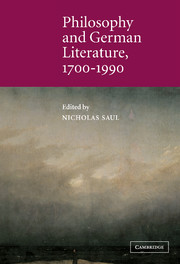Book contents
- Frontmatter
- Contents
- Contributors
- Acknowledgements
- List of abbreviations
- Introduction: German literature and philosophy
- Chapter One Criticism and experience: philosophy and literature in the German Enlightenment
- Chapter Two The pursuit of the subject: literature as critic and perfecter of philosophy 1790–1830
- Chapter Three Two realisms: German literature and philosophy 1830–1890
- Chapter Four Modernism and the self 1890–1924
- Chapter Five The subjects of community: aspiration, memory, resistance 1918–1945
- Chapter Six Coming to terms with the past in postwar literature and philosophy
- Bibliography
- Index
Chapter Three - Two realisms: German literature and philosophy 1830–1890
Published online by Cambridge University Press: 22 September 2009
- Frontmatter
- Contents
- Contributors
- Acknowledgements
- List of abbreviations
- Introduction: German literature and philosophy
- Chapter One Criticism and experience: philosophy and literature in the German Enlightenment
- Chapter Two The pursuit of the subject: literature as critic and perfecter of philosophy 1790–1830
- Chapter Three Two realisms: German literature and philosophy 1830–1890
- Chapter Four Modernism and the self 1890–1924
- Chapter Five The subjects of community: aspiration, memory, resistance 1918–1945
- Chapter Six Coming to terms with the past in postwar literature and philosophy
- Bibliography
- Index
Summary
The two most important facts about German literary realism in its European context are its difference and its difficulty of definition. One of the most important reasons for both is the way German literary realism in the nineteenth century is closely linked to, yet never identical with, a philosophical discourse about what ‘reality’ means. Both the link and the difference between literary and philosophical discourse are sharply focused in one of German realism's earliest and most canonical texts, Georg Büchner's Lenz of 1835.
Büchner's Novelle is a narrative of the mental illness of the poet Lenz. In the middle of the story, however, is a dialogue concerned with the relationship between art and reality. In this dialogue, the Kunstgespräch, Lenz debates with the visitor Kaufmann the relationship between artistic creation and reality itself. Büchner's narrator, using an overtly philosophical vocabulary, describes the time as the beginning of the ‘idealistic’ period in German literature, and Lenz's position is defined in radical opposition to that movement. The philosophical question marks implicit in the use of the term ‘idealistische Periode’ are underscored by Lenz's response. Lenz objects to the view that the task of art is aesthetic transfiguration (‘Verklärung’) of reality. But he objects equally to the idea that the object of literature is to reproduce reality itself. Lenz's response (which includes no semantic opposite to Kaufmann's ‘idealistisch’) cannot be equated with any naive doctrine of realism, philosophical or literary.
- Type
- Chapter
- Information
- Philosophy and German Literature, 1700–1990 , pp. 102 - 149Publisher: Cambridge University PressPrint publication year: 2002
- 1
- Cited by



